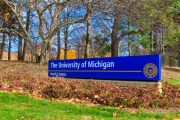It was an image (shown) of a stick figure being hanged, accompanied by the slur “Nig***!” and the hashtag #WhitePower. And it created quite a stir when it was discovered at a library at Salisbury University in Maryland on April 10, with the police poised to file hate-crime charges.
That is, until it was learned the perpetrators were black.
Now, apparently, the authorities don’t want those responsible to become “justice-involved youth,” to use Attorney General Loretta Lynch’s descriptive. In fact, the Washington Times reports that not only won’t the school provide the perpetrators’ names, “citing the federal Family Educational Rights and Privacy Act,” but additionally, “No charges are expected to be filed.”
Instead, the Daily Times reports that the “investigation is being turned over to the university and will be reviewed for any possible university policy violations.” The paper continued, “If charged, those students who were involved could face disciplinary action.” Of course, with the matter now hush-hush in privacy’s name, we may never know what this possible disciplinary action might be.
Prior to the perpetrators’ discovery, university president Janet Dudley-Eshbach issued a stern statement, writing, “Diversity is a core value of SU, and reports of such acts are taken seriously. The university will not tolerate this kind of language or behavior.” Critics may suspect, however, that her tolerance level for the April 10 act has now increased just a smidgeon.
And many note the double standard. Instapundit.com’s Glenn Reynolds writes, “Yeah, if this were genuine and the students were white, we’d know their names.” American Thinker’s Thomas Lifson asks rhetorically, “If white students had been the perpetrators, would they have been let off with no legal consequences?” And alluding to how the Left’s racial agenda doesn’t miss a beat even though many “hate crimes” are being perpetrated by members of the targeted groups themselves, Times commenter Justin Darling lamented, “It doesn’t even matter…. The movement marches forward despite facts.”
And the fact is that one could ask, as Reynolds did, “WITHOUT FAKE HATE CRIMES, WOULD WE HAVE ANY HATE CRIMES AT ALL?” Consider that the Daily Caller provides a whole page of what it terms “recent race hoaxes.” They include a black student at Saginaw Valley State University who declared on social media, “I’m going to shoot every black person I can on campus”; a claim that the Ku Klux Klan was roaming the University of Missouri; images of swastikas and the words “white power” written in snow at Calvin College; and a black graduate of Kean University who, as the DC writes, “used a school computer to threaten to ‘shoot every black woman and male’ on campus.”
I provided a number of related examples as well in 2014, including a black Red Lobster waitress who wrote the slur “nig***” on a takeout-order receipt and claimed it was written by her white customers, and a lesbian waitress who accused her customers of leaving a note expressing disapproval with her sexuality. (In a similar vein, while speaking to a mainly black audience in 2007, Barack Obama knowingly and falsely claimed that Hurricane Katrina victims were denied adequate federal aid because they were black.)
In virtually every case, these perpetrators aren’t held to account in the way they would had the incidents not been labeled “hoaxes.” Now first note that, as Thomas Lifson points out, the First Amendment does not permit “prosecution for expression of racial animus.” And in pursuing such, authorities proceed as if we had hate-speech laws — as exist in most of the West — even though they would most assuredly be ruled unconstitutional if actually enacted. Moreover, hate-crime laws, which we do have, are cut from the same stone. After all, they prescribe more punishment for a given criminal act if it’s deemed to have been motivated by “hate” (as defined by the day’s fashions). But what is that extra punishment for if not the thoughts expressed via the act? Thus, are hate-crime laws not an effort at thought control?
Whatever the case, these laws do exist, and they’re not applied equally. And part of the problem is hinted at by our terminology. Much as how “reverse racism” is nothing but straight-ahead bigotry, should we really consider acts such as the Salisbury University (SU) one “hoaxes”? They certainly are not in the sense that the Piltdown man was a hoax; it simply was not what it was claimed to be. Yet the SU drawing was materially the same — a racially inflammatory image — regardless of who drew it.
Of course, the intentions motivating the act were certainly different (buttressing the earlier point about thought control). Yet there’s a problem if this argument is now used to justify the double standard in prosecution:
Leftists have long denied that the additional punishment hate-crime laws prescribe is for the thoughts expressed through the act.
Rather, they claim it’s justified because, as this Berkeley University website puts it, these “crimes victimize everyone — individuals and our entire community.”
Yet if it’s true that the act alone has that effect, then it matters not who drew the SU image; the entire community was victimized regardless. And, of course, it was in the sense of the unrest created.
At this point, hate-crime-law defenders can only justify their kid-glove treatment of the SU “artists” by claiming intentions do matter, that the black community won’t feel victimized because they now know the drawing wasn’t created by “hateful” whites. But even if true, were they not then victimized during the period between the discovery of the image and the discovery of its creators’ race? Can we now “victimize” a group for a week or two with impunity?
Moreover, accepting the community-victimization thesis, note that the only reason the image didn’t have its victimizing effect was that its creators failed in their mission by being discovered. But does this matter? If a man attempts a murder or bank robbery and fails, do we give him a pass and say “You’re just lucky you didn’t pull it off”?
Then, since at issue is community-wide effect, what about the effect on the white community — and the wider community — by attempting to implicate whites in the SU trespass? And since when does committing a crime in an effort to frame another mean no punishment?
Stoking the fires of racial and ethnic strife — which has killed countless millions throughout history — is no joke. But if we’ll accept that “hate crimes” can be mitigated by intention, what of the white kid who draws a racial image out of ignorance, while drunk, or just to provoke a reaction? Is he assumed “hateful” merely because of his skin color? And were the SU perpetrators driven by love?
So race doesn’t matter, except when it does. Intentions don’t matter, except when they do. And it’s only the acts that matter, except when they don’t. So much for equality under the law.




